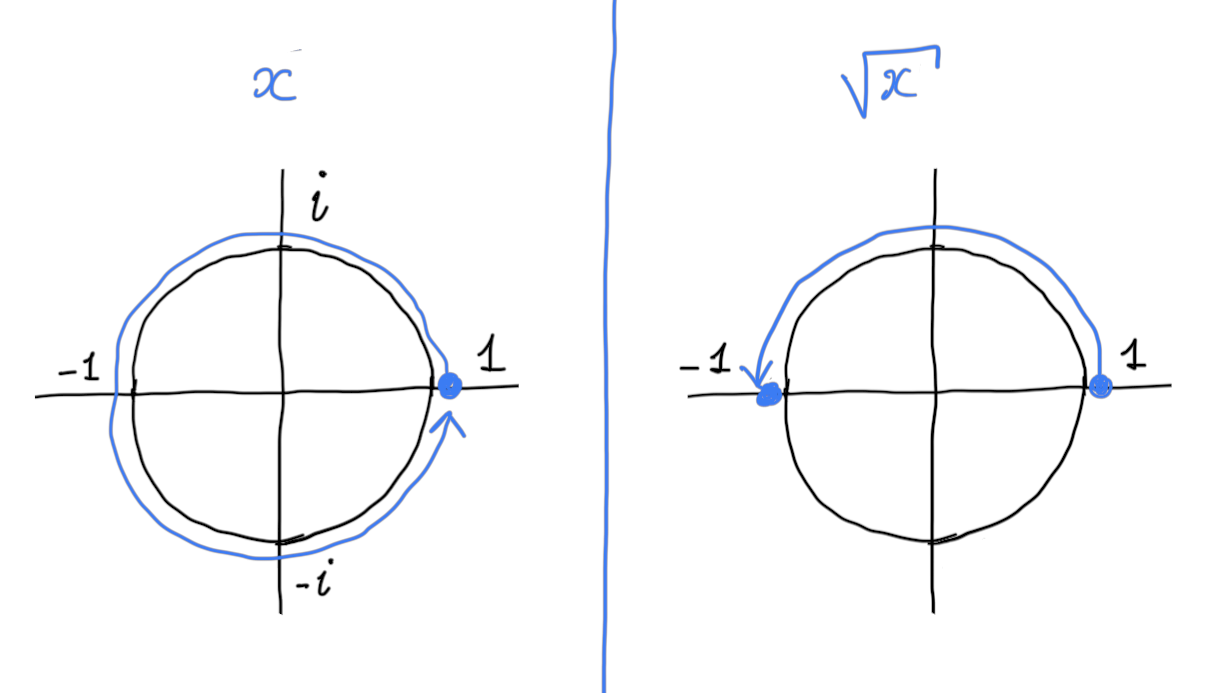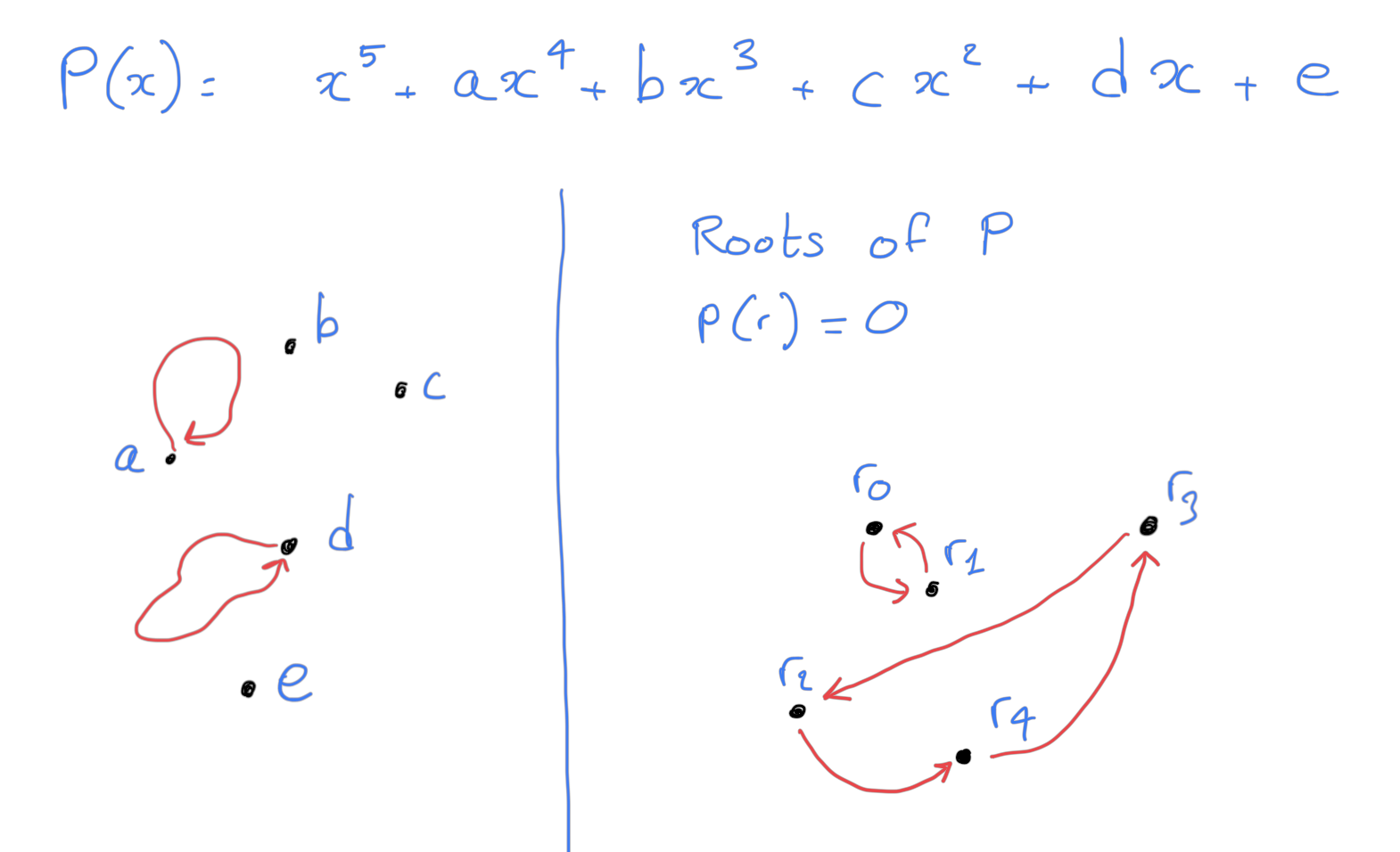The Abel-Ruffini theorem states that there is no solution to the general
polynomial equation of degree five (quintic equation) that can be expressed
with the common operations: (+, -, x, %), plus √ (radical of any degree).
In this post I’ll try to give my quick understanding of the proof, without explicitly relying on group theory or Riemann surface. As usual on this blog, this is all hand wavy. For a proper introduction to the proof I recommend the excellent book “Abel’s Theorem in Problems and Solutions” by V.B. Alekseev.
The proof relies on the non-intuitive fact that certain functions of complex numbers can change values when we smoothly move the arguments along a closed loop. Let’s take the function y = √x for example, starting with x = 1, and y = 1. If we smoothly rotate x along the unit circle, y will also rotate at half the speed. As we return to x = 1, y will be equal to -1.

Permutations of the polynomial root solutions
Let’s assume that we have a function $(r0, r1, r2, r3, r4) = F(a, b, c, d, e)$ that gives us the roots of a polynomial of degree 5 from its coefficient.
It is easy to find the coefficient from the roots, since we know that the polynomial can be written as the product of the roots minus x:
$$ P(x) = (r0 - x)(r1 - x)(r2 - x)(r3 - x)(r4 - x) $$
By expending this and matching with the polynomial in its original form we can directly recompute the coefficients, which mean we can easily find the inverse function:
$$ (a, b, c, d, e) = F’(r0, r1, r2, r3, r4). $$
If we smoothly move the roots value in order to shuffle them, the coefficients will return to the same values, so we also have the possibility of doing closed loops of the coefficients resulting in any permutations of the roots. This is the property that we are interested in: we will show that expressions with radicals are not flexible enough to allow for all permutations of the five roots of the quintic polynomial.

Restriction on the permutations with a single radical
If we consider an expression with only one radical, something like: $r = a + \sqrt[4]{b + c}$. We have four possible values for r (given that used a fourth root), but not all permutations are possible.
We can easily see that as we apply a loop, all the values will move together at the same time, so that we can for example do a permutation r0 → r1 → r2 → r3 → r0 but not r0 → r1 → r0. In general the restriction is that if we take the set of all the possible permutations, applying two of them in any order should result in the same permutations. We can express that by using the commutator of two permutations, which is the final permutation we get if we apply two permutation followed by their inverse: $[A, B] = A B A^{-1} B^{-1}$.
So the restriction of any expression involving a single radical is that the set of commutators for any possible permutation of the values we can get by doing closed loops of the arguments should contain only the identity.
Already we can tell that the expression for the quintic polynomial roots, if it exists, cannot be using a single radical operator, since otherwise we would not be able to do any permutations of the five roots.
Representation of any expression as a graph
What about if we use more radicals, in particular if we use an expression with radicals of radicals? Maybe this allows us to get some more complex permutations, and can we still find some restriction on the set of possible permutations? In order to reason about composed expression, it is interesting to see that we can express an expression as a tree of simple operations. For example if we have this expression:
$\sqrt[5]{\sqrt[4]{a^2 + \sqrt[3]{b / c}} - \sqrt[2]{d * e}}$
We could map it to this kind of graph:
Every node represents an intermediary expression that is using only at most a single radical operation.
Recursive elimination of permutations from the full set
If we imagine that the solution to the quintic equation exists, and we have its graph as a tree of simple operations. We know from our previous discussion that by smoothly looping the coefficients of the polynomial, we can permute any of the root. This mean that all the 5! = 120 permutations of five values are doable. We can write them like that:
(01234), (01243), (01324), (01342), …
Now the main element of the proof is the following observation:
If we consider only the set of all commutators of the 120 permutations, then in our expression tree, all the leaf nodes will stay at the same value, because they only have at most a single radical operation.
This means that if we restrict ourselve to the commutators subset, the leaf node behaves exactly like a ’non radical’ expression, and we can then remove them all from the tree, making their parent nodes the new leaf nodes.
If we repeat this process again, we will eventually have a tree made of a single node for the final expression, with no radical. At this point the set of permutations should only contain the identity.
Final part of the proof using python
All we have to do now to prove that there is no solution to the quintic equation is to show that we cannot go from the 120 permutations of five elements to a single identity permutation by iteratively computing the subset of all commutators. To do that we can use a small python script:
import itertools
def inv(p):
"""inverse of a permutation"""
return sorted(range(len(p)), key=p.__getitem__)
def mul(a, b):
"""Apply permutation a on b"""
return tuple([b[x] for x in a])
def chain(*ps):
"""Chain apply a list of permutations"""
*_, last = itertools.accumulate(ps, mul)
return last
def commutator(a, b):
"""Return commutator of two permutations"""
return chain(a, b, inv(a), inv(b))
def permutation_group(n):
"""Return the set of all permutation of n elements"""
return set(itertools.permutations(range(n)))
def all_commutators(g):
"""Return the set of all commutators of a set of permutations"""
ret = set()
for a, b in itertools.product(g, g):
ret.add(commutator(a, b))
return ret
s = permutation_group(5)
for i in range(5):
print(f"{i}:{len(s)}")
s = all_commutators(s)
Result:
0:120
1:60
2:60
3:60
4:60
We see that after the first step the set goes from 120 permutations to only 60, but after that the set stays at 60 permutations, which means the commutators subset is the same as the set itself.
This proves that no matter how complicated, there is no graph of an expression that can be reduced to a single node using our process, which means that there is no expression that supports any permutation of the roots, which means that there is no solution in radical for the quintic equation.